Wagon Plays
For the 2022 production with cast, see this archive page.
For the 2018 production, see this page.
For the 2014 production, see this page.
In the Middle Ages, the Plays were presented on wagons that were pulled by craft guild members from one 'playing station' in York's streets to another. This was each Corpus Christi Day; it usually falls in June.
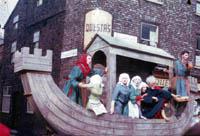
In 1951 a very practical decision was made to present the plays in one static space - the romantic ruins of St Mary's Abbey, in Museum Gardens. But Canon Purvis, responsible for providing a playing text for the production, also produced the script for a 'Wagon Play' focusing on one of the stories not featured in the 'main' production. In each of the subsequent productions at three-year intervals, a different story (such as The Flood, or Exodus, or The Harrowing of Hell) would be presented on a wagon by youngsters from the Archbishop Holgate Grammar School.
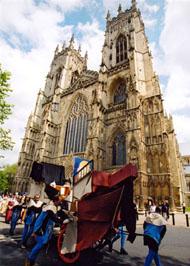 In the 1970s two scholarly attempts (in Leeds and Toronto) were made to reconstruct the York Cycle in its processional form. The University of Lancaster (especially Meg Twycross) continued these 'experiments' in York. In 1988, wagons were on Stonegate and Low Petergate with new performers: Bretton Hall College - The Crucifixion
In the 1970s two scholarly attempts (in Leeds and Toronto) were made to reconstruct the York Cycle in its processional form. The University of Lancaster (especially Meg Twycross) continued these 'experiments' in York. In 1988, wagons were on Stonegate and Low Petergate with new performers: Bretton Hall College - The CrucifixionLords of Misrule (York) - Death and Burial of Christ
Durham Medieval Drama Group - Harrowing of Hell
Joculatores Lancastrienses - Resurrection
University of Groningen - Christ's Appearance to Mary Magdalen.-640x480.jpg)
-640x480.jpg)
In 1992, to accompany Mystery Play performances in the Theatre Royal, the Wakefield Play and the York Pageant of Herod and the Three Kings were performed on a wagon in the courtyard of Barley Hall (restored by York Archaeological Trust).In 1994 Leeds-based historian Jane Oakshott worked with the Friends of York Mystery Plays, the Centre for Medieval Studies at the University of York and the York Early Music Festival to direct the first processional performance of York's Plays in modern times. This innovative production involved nine amateur drama groups on 10 July at five playing stations (Dean's Park, King's Square, the market place, St Sampson's Square and Parliament Street). It was a considerable success.
In 1998, Jane Oakshott returned to York to direct a second processional performance. She brought eleven plays to the streets, ambitiously re-creating some stunning theatrical sets and, for the first time since the the plays ended around 1570, involving the York Guilds in their own tradition.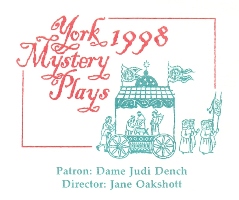
In 1998, Jane Oakshott returned to York to direct a second processional performance. She brought eleven plays to the streets, ambitiously re-creating some stunning theatrical sets and, for the first time since the the plays ended around 1570, involving the York Guilds in their own tradition.

By 2002 this initiative had blossomed and the Guilds themselves presented a cycle of ten plays at five playing stations under the direction of Mike Tyler. In 2008 Jane Oakshott was awarded an MBE for her pioneering revival of street performance of the English Mystery Plays.
The Guilds and other groups such as York Settlement Community Players, York Civic Trust, the University of York St John and local church groups have continued to 'bring forth' wagon plays in 2006, 2010, 2014, 2018 and 2022. This image shows actors from the Butchers' Guild hauling Christ up, having nailed him to the Cross. Their wagon is specially built. In 2018 the cycle of Plays was performed in September led by Artistic Director Tom Straszewski. Regular locations for the wagons - St Helen's Square, St Sampsons Square, College Green, and Museum Gardens - were supplemented by the Shambles Market.
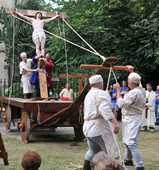
Below right, the Guild of Builders approach the playing station near Clifford's Tower in 2010. Their Guild performs The Creation of the World to the Fifth Day.
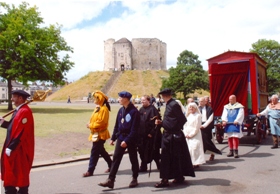
This Flickr site has more images of the 2010 wagon plays.
For the Guilds' Wagon Plays in July 2014 see this page. For the cast list, see this page.
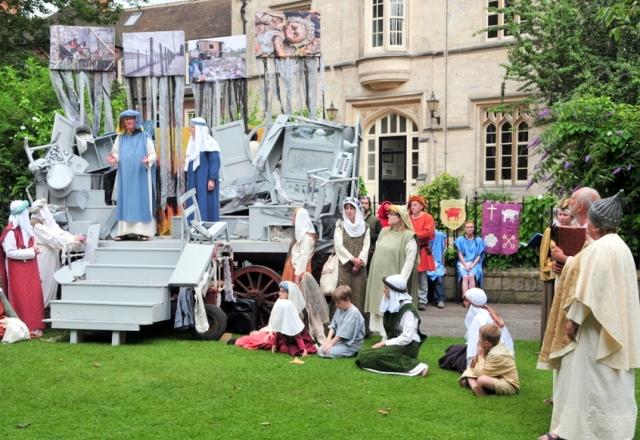
Two wagon plays complemented the Museum Gardens production in 2012, and there is a page of photographs.